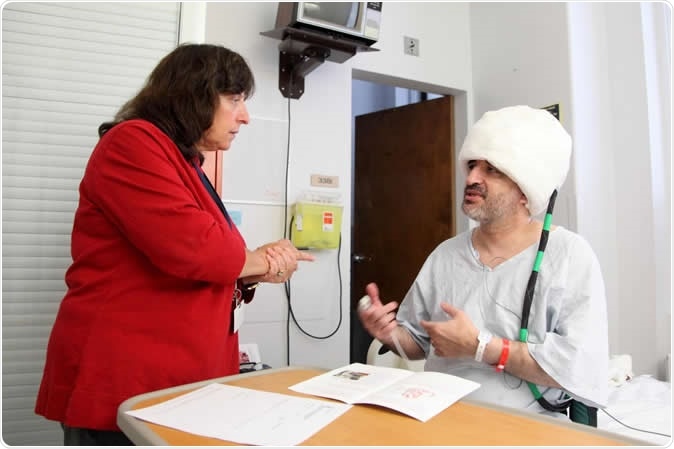The use of cortical stimulation to induce artificial seizures in epileptic patients waiting for surgery could greatly speed up their assessment while improving surgical outcome, according to a new study published on June 10, 2019, in the Journal of the American Medical Association.

Epilepsy patients with inserted electrodes often undergo cortical stimulation, a procedure that applies electrical current to the brain to map brain function but also to induce seizures for better understanding of the epileptic network. Image Credit: The Neuro
In about a third of epilepsy cases, drug treatment fails, and surgery is the only resort. In such cases, the patients need to be hospitalized for up to two weeks to be observed for seizures. By recording this seizure activity, the source is revealed, so that surgeons can treat the right cortical area in order to inhibit future seizures.
However, this long period of hospitalization is not only a source of great inconvenience for the patients but strains healthcare finances as well.
Cortical stimulation, using electrodes to stimulate the brain, is used in 20% of epileptic patients awaiting surgery. This not only helps the doctors to localize various functional areas in the brain, but may also be used to produce seizure activity that helps to map out the area of the brain cortex from which the abnormal electrical activity originates.
However, the outcome of surgery based on the results of this type of cortical stimulation has not yet been studied on a systematic basis.
The current study aimed to find out whether the routine use of cortical stimulation to elicit seizures could help plan the surgery just as well as waiting for a spontaneous seizure.
The study uses data gathered from over a hundred epilepsy patients being treated at tertiary epilepsy centers in Canada and France. Led by Dr Birgit Frauscher, the researchers analyzed the findings of cortical stimulation, which was used in 57% of the patients. They looked at whether its use led to the successful induction of seizures that are both electrically and clinically similar to the patient’s spontaneous seizures. They also explored how cortical stimulation-based planning of the zone of resection of epileptic foci was reflected in the final patient outcome following surgery.
The statistics show that 70% of patients who had stimulated seizures during their presurgical planning had good outcomes compared to 48% of those in whom seizures could not be induced. The seizure onset zones were also successfully mapped by monitoring induced seizures just as with spontaneous seizures. In stimulated patients with a good surgical outcome, 63% of the identified seizure onset zone contacts were resected, but only 33% in those with a poor outcome. The corresponding figures in patients whose surgery was based on spontaneous seizure monitoring were 57% and 33% for good and bad outcomes, respectively. The researchers also noted that it was easier to induce seizures after an interval of at least 24 hours since the last episode, at 65% compared to 27% with a shorter gap.
This would mean that there is strong evidence for using cortical stimulation to produce artificial seizures in order to locate the seizure focus in the brain. Both induced and spontaneous seizures are equally effective in mapping the sites of seizure generation in the brain. In this case, the use of seizure induction could mean a dramatic reduction in hospital stay duration, while saving enormously on costs.
Dr Frauscher’s clinic has already switched to routine cortical stimulation for presurgical epilepsy patients as standard practice. Her team uses electrode insertion early in the patient’s stay to induce seizures and complete the patient’s observation. She sees it as highly probable that other facilities will follow the same trend in view of its great advantages.
While brain mapping with cortical stimulation is nothing new, the study produced evidence for the first time that its use in inducing seizures produces results that closely resemble spontaneous seizures. This procedure could therefore be performed early, reducing the period of hospitalization required.
Dr Frauscher sums up her view: “"I think it would be a huge advantage if this procedure was done in the first days of a patient's stay. Instead of being in hospital for two weeks, patients can maybe be there for 48 or 72 hours and we only need to record maybe one additional spontaneous seizures and not several, and that is a huge difference."
Related Video
Cortical Stimulation Stereotactic EEG Test for Epilepsy